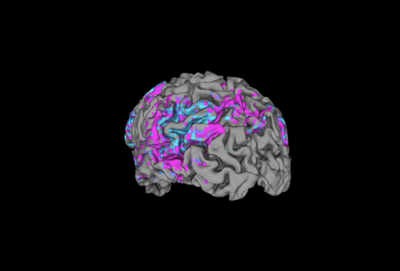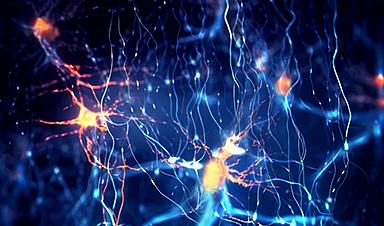By eavesdropping on the brains of living people, scientists have created the highest-resolution map yet of the neurons that encode the meanings of various words1. The results hint that, across individuals, the brain uses the same standard categories to classify words — helping us to turn sound into sense.
The study is based on words only in English. But it’s a step along the way to working out how the brain stores words in its language library, says neurosurgeon Ziv Williams at the Massachusetts Institute of Technology in Cambridge. By mapping the overlapping sets of brain cells that respond to various words, he says, “we can try to start building a thesaurus of meaning”.
The work was published today in Nature.
Mapping meaning
The brain area called the auditory cortex processes the sound of a word as it enters the ear. But it is the brain’s prefrontal cortex, a region where higher-order brain activity takes place, that works out a word’s ‘semantic meaning’ — its essence or gist.
Previous research2 has studied this process by analysing images of blood flow in the brain, which is a proxy for brain activity. This method allowed researchers to map word meaning to small regions of the brain.
But Williams and his colleagues found a unique opportunity to look at how individual neurons encode language in real time. His group recruited ten people about to undergo surgery for epilepsy, each of whom had had electrodes implanted in their brains to determine the source of their seizures. The electrodes allowed the researchers to record activity from around 300 neurons in each person’s prefrontal cortex.
As participants listened to multiple short sentences containing a total of around 450 words, the scientists recorded which neurons fired and when. Williams says that around two or three distinct neurons lit up for each word, although he points out that the team recorded only the activity of a tiny fraction of the prefrontal cortex’s billions of neurons. The researchers then looked at the similarity between the words that activated the same neuronal activity.
A neuron for everything
The words that the same set of neurons responded to fell into similar categories, such as actions, or words associated with people. The team also found that words that the brain might associate with one another, such as ‘duck’ and ‘egg’, triggered some of the same neurons. Words with similar meanings, such as ‘mouse’ and ‘rat’, triggered patterns of neuronal activity that were more similar than the patterns triggered by ‘mouse’ and ‘carrot.’ Other groups of neurons responded to words associated with more-abstract concepts: relational words such as ‘above’ and ‘behind’, for instance.

Mind-reading machines are here: is it time to worry?
The categories that the brain assigns to words were similar between participants, Williams says, suggesting human brains all group meanings in the same way.
The prefrontal cortex neurons didn’t distinguish words by their sounds, only their meanings. When a person heard the word ‘son’ in a sentence, for instance, words associated with family members lit up. But those neurons didn’t respond to ‘Sun’ in a sentence, despite these words having an identical sound.
Mind reading
To an extent, the researchers were able to determine what people were hearing by watching their neurons fire. Although they couldn’t recreate exact sentences, they could tell, for example, that a sentence contained an animal, an action and a food, in that order.
“To get this level of detail and have a peek at what’s happening at the single-neuron level is pretty cool,” says Vikash Gilja, an engineer at the University of California San Diego and chief scientific officer of the brain–computer interface company Paradromics. He was impressed that the researchers could determine not only the neurons that corresponded to words and their categories, but also the order in which they were spoken.
Recording from neurons is much faster than using imaging; understanding language at its natural speed, he says, will be important for future work developing brain–computer interface devices that restore speech to people who have lost that ability.
News
Nano-Enhanced Hydrogel Strategies for Cartilage Repair
A recent article in Engineering describes the development of a protein-based nanocomposite hydrogel designed to deliver two therapeutic agents—dexamethasone (Dex) and kartogenin (KGN)—to support cartilage repair. The hydrogel is engineered to modulate immune responses and promote [...]
New Cancer Drug Blocks Tumors Without Debilitating Side Effects
A new drug targets RAS-PI3Kα pathways without harmful side effects. It was developed using high-performance computing and AI. A new cancer drug candidate, developed through a collaboration between Lawrence Livermore National Laboratory (LLNL), BridgeBio Oncology [...]
Scientists Are Pretty Close to Replicating the First Thing That Ever Lived
For 400 million years, a leading hypothesis claims, Earth was an “RNA World,” meaning that life must’ve first replicated from RNA before the arrival of proteins and DNA. Unfortunately, scientists have failed to find [...]
Why ‘Peniaphobia’ Is Exploding Among Young People (And Why We Should Be Concerned)
An insidious illness is taking hold among a growing proportion of young people. Little known to the general public, peniaphobia—the fear of becoming poor—is gaining ground among teens and young adults. Discover the causes [...]
Team finds flawed data in recent study relevant to coronavirus antiviral development
The COVID pandemic illustrated how urgently we need antiviral medications capable of treating coronavirus infections. To aid this effort, researchers quickly homed in on part of SARS-CoV-2's molecular structure known as the NiRAN domain—an [...]
Drug-Coated Neural Implants Reduce Immune Rejection
Summary: A new study shows that coating neural prosthetic implants with the anti-inflammatory drug dexamethasone helps reduce the body’s immune response and scar tissue formation. This strategy enhances the long-term performance and stability of electrodes [...]
Scientists discover cancer-fighting bacteria that ‘soak up’ forever chemicals in the body
A family of healthy bacteria may help 'soak up' toxic forever chemicals in the body, warding off their cancerous effects. Forever chemicals, also known as PFAS (per- and polyfluoroalkyl substances), are toxic chemicals that [...]
Johns Hopkins Researchers Uncover a New Way To Kill Cancer Cells
A new study reveals that blocking ribosomal RNA production rewires cancer cell behavior and could help treat genetically unstable tumors. Researchers at the Johns Hopkins Kimmel Cancer Center and the Department of Radiation Oncology and Molecular [...]
AI matches doctors in mapping lung tumors for radiation therapy
In radiation therapy, precision can save lives. Oncologists must carefully map the size and location of a tumor before delivering high-dose radiation to destroy cancer cells while sparing healthy tissue. But this process, called [...]
Scientists Finally “See” Key Protein That Controls Inflammation
Researchers used advanced microscopy to uncover important protein structures. For the first time, two important protein structures in the human body are being visualized, thanks in part to cutting-edge technology at the University of [...]
AI tool detects 9 types of dementia from a single brain scan
Mayo Clinic researchers have developed a new artificial intelligence (AI) tool that helps clinicians identify brain activity patterns linked to nine types of dementia, including Alzheimer's disease, using a single, widely available scan—a transformative [...]
Is plastic packaging putting more than just food on your plate?
New research reveals that common food packaging and utensils can shed microscopic plastics into our food, prompting urgent calls for stricter testing and updated regulations to protect public health. Beyond microplastics: The analysis intentionally [...]
Aging Spreads Through the Bloodstream
Summary: New research reveals that aging isn’t just a local cellular process—it can spread throughout the body via the bloodstream. A redox-sensitive protein called ReHMGB1, secreted by senescent cells, was found to trigger aging features [...]
AI and nanomedicine find rare biomarkers for prostrate cancer and atherosclerosis
Imagine a stadium packed with 75,000 fans, all wearing green and white jerseys—except one person in a solid green shirt. Finding that person would be tough. That's how hard it is for scientists to [...]
Are Pesticides Breeding the Next Pandemic? Experts Warn of Fungal Superbugs
Fungicides used in agriculture have been linked to an increase in resistance to antifungal drugs in both humans and animals. Fungal infections are on the rise, and two UC Davis infectious disease experts, Dr. George Thompson [...]
Scientists Crack the 500-Million-Year-Old Code That Controls Your Immune System
A collaborative team from Penn Medicine and Penn Engineering has uncovered the mathematical principles behind a 500-million-year-old protein network that determines whether foreign materials are recognized as friend or foe. How does your body [...]





















